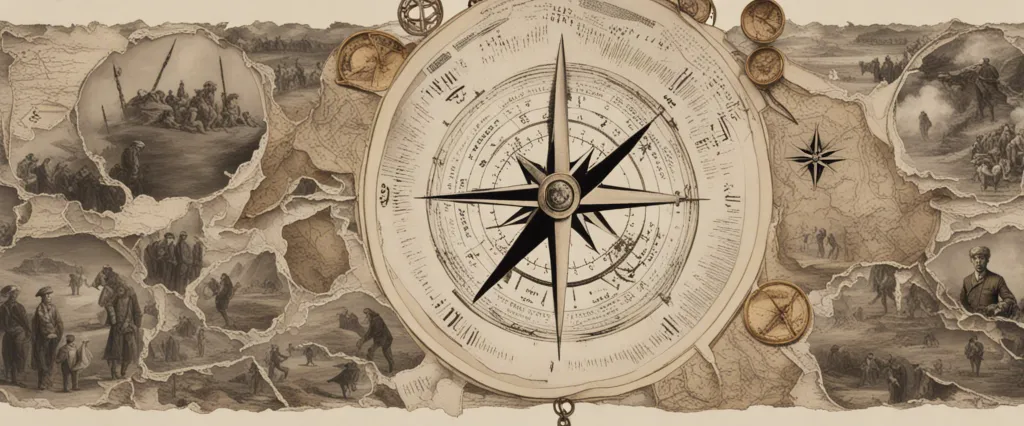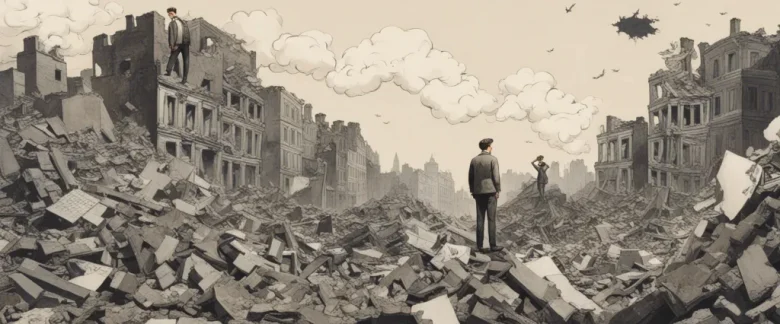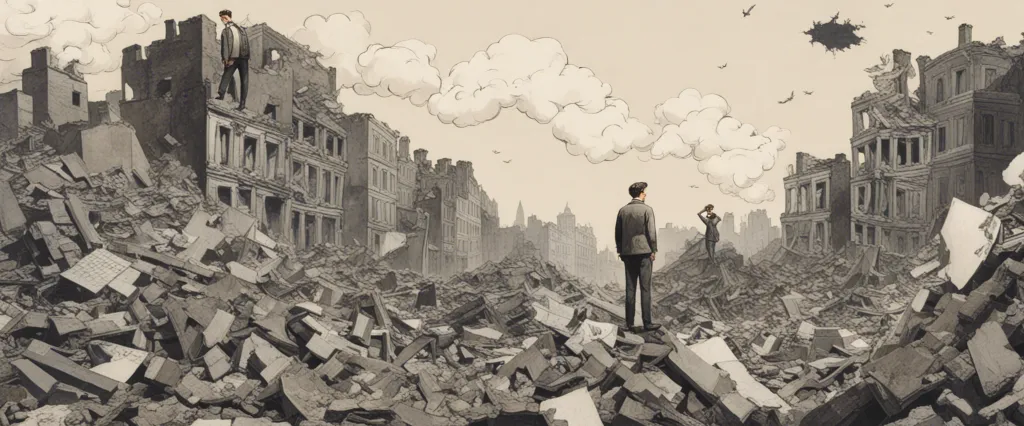In his thought-provoking book, “Savage Continent,” renowned historian Keith Lowe delves into the turbulent aftermath of the Second World War, revealing the harrowing tales of a continent left devastated by the conflict. With meticulous research and gripping storytelling, Lowe examines the widespread chaos, violence, and anarchy that engulfed Europe in the post-war years. As an acclaimed historian and author, Keith Lowe has dedicated his career to uncovering the lesser-known narratives of World War II and its aftermath, shedding light on the untold stories that shaped the post-war global landscape.
Chapter 1: Europe in Ruins
Chapter 1 of “Savage Continent” by Keith Lowe, titled “Europe in Ruins,” provides a comprehensive overview of the devastating aftermath of World War II on the European continent. The chapter delves into the physical, emotional, and socio-political chaos that engulfed the region in the immediate aftermath of the war.
Lowe begins by describing the extensive destruction caused by the war, which left almost every European city in ruins. The author emphasizes that the destruction wasn’t limited to buildings, but also encompassed the annihilation of millions of lives and the disintegration of established societal structures.
The chapter also sheds light on the psychological toll suffered by individuals and communities throughout Europe. The trauma inflicted by the war reverberated in the form of post-war violence, displacement, and the loss of loved ones. Lowe explores how the survivors found themselves grappling with the haunting memories of war, leading to a deep sense of despair and a struggle to rebuild their lives.
Furthermore, the author highlights the political disarray resulting from the war. The collapse of countries’ governments, the weakened trust in traditional political institutions, and the rise of various factions seeking power rendered Europe vulnerable to chaos. Lowe discusses the power vacuums that allowed extremist ideologies to take root and compete for control in different regions.
In conclusion, Chapter 1 of “Savage Continent” vividly portrays the profound devastation that affected Europe after World War II. The physical destruction, emotional trauma, and political instability cast a dark shadow over the continent, presenting immense challenges to its inhabitants as they sought to rebuild their shattered lives.
Chapter 2: Revenge and Violence
Chapter 2 of Keith Lowe’s book, “Savage Continent,” titled “Revenge and Violence,” examines the aftermath of World War II in Europe, diving into the reactions and actions of individuals and communities who had endured years of brutality and destruction. The chapter highlights the waves of violence that swept across the continent as people sought vengeance for wartime suffering.
Lowe begins by acknowledging the deep-rooted desire for revenge that permeated post-war Europe. This desire was driven by the atrocities committed during the war, including the Holocaust, ethnic cleansing, and the widespread devastation caused by bombings and occupation. As the war ended, the absence of an organized authority, coupled with broken societies and displaced populations, fueled anarchy and violence.
The author then delves into the horrifying examples of retribution and vengeance, recounting stories of bloody reprisals against collaborators, prisoners of war, and enemies of different ethnic backgrounds. Lynchings, executions, and mob violence became alarmingly common as communities sought justice on their own terms.
Lowe highlights the violence inflicted by various groups, including Soviet forces, who took advantage of their control over Eastern Europe to extract revenge against their former oppressors. He also examines the actions of Holocaust survivors who sought to identify, locate, and punish the Nazis and their collaborators, often through secretive organizations and covert operations.
Throughout the chapter, Lowe is careful to illustrate the complexity of revenge and its consequences, delving into the moral dilemmas faced by societies grappling with their own impulses for retribution. Ultimately, he emphasizes that the extraordinary violence experienced in the immediate aftermath of the war was a direct result of deeper issues caused by years of systemic brutality and dehumanization.
In “Revenge and Violence,” Lowe captures the raw emotions and widespread brutality that engulfed post-war Europe.
Chapter 3: Displaced Populations
Chapter 3 of “Savage Continent” by Keith Lowe focuses on the mass displacement of populations in Europe in the aftermath of World War II. This period witnessed a wave of migrations, expulsions, and forced resettlements that reshaped the demographic landscape of the continent.
The chapter begins by highlighting the disarray and chaos that prevailed in post-war Europe. With the collapse of regimes, borders redrawn, and millions of people left homeless, a vast number of displaced populations emerged. Lowe emphasizes that the displaced encompassed a wide range of people, including prisoners of war, concentration camp survivors, refugees, and civilians who were uprooted from their homes during the war.
Lowe explores the extensive forced migration of Germans from various regions of Europe. The author details the expulsion of over 12 million Germans from territories that were handed over to Poland and the Soviet Union. These expulsions often led to violence, including rapes, murders, and other atrocities against the German population.
Furthermore, the chapter delves into the challenges faced by the millions of displaced Jews who survived the Holocaust. They encountered tremendous difficulties finding new homes due to anti-Semitic sentiments in their former communities and the reluctance of other nations to accept them.
Lowe also examines the plight of prisoners of war and concentration camp survivors who were liberated by Allied forces. Many of these individuals suffered from physical and emotional trauma and struggled to rebuild their lives.
In summary, Chapter 3 of “Savage Continent” focuses on the immense displacement of populations in post-war Europe. It explores the forced migration of Germans, the challenges faced by Jewish survivors, and the hardships endured by liberated prisoners. This chapter highlights the profound consequences of the war, as millions of people had to endure displacement, loss, violence, and uncertainty in their search for new homes and identities.
Chapter 4: Post-War Racial Hatred

Chapter 4 of “Savage Continent” by Keith Lowe focuses on the post-war racial hatred that was prevalent across Europe in the aftermath of World War II. The chapter delves into the atrocities, revenge, and ethnic cleansing that occurred during this period, shedding light on the deep-rooted prejudices and tensions that had been exacerbated by the war.
Lowe begins by illustrating how the end of the war did not mark the end of violence and hatred. Many revenge-fueled acts were committed, especially against collaborators who were seen as traitors to their respective nations. These acts varied in severity, from minor humiliations to extreme torture and lynching. The author emphasizes that this was not limited to one particular group; revenge was sought by different factions, including Communists, nationalists, and the masses affected by Nazi occupation.
Additionally, the chapter explores the victimization and displacement of minority groups. Members of ethnic and religious minorities, such as Jews, Roma, and Poles, became scapegoats for the challenges faced by their communities after the war. There was a widespread belief in racial superiority and a desire to dominate or eliminate these groups. Ethnic cleansing occurred in various forms, as people were expelled from their homes, sent to concentration camps, or brutally murdered.
Lowe also sheds light on the large-scale forced migrations that took place in this period. Millions of people were uprooted from their native lands due to border changes or the newly formed nation-states in Eastern Europe. These displacements often led to violence, as different ethnic groups clashed over territory.
In summary, Chapter 4 of “Savage Continent” highlights the persistence of racial hatred and the deep scars left by World War II. The atrocities committed, revenge sought, and ethnic cleansings that occurred reveal the profound impact of this hatred, as communities struggled to rebuild amidst a backdrop of violence and tension.
Chapter 5: Reconstruction and Recovery
Chapter 5 of “Savage Continent” by Keith Lowe focuses on the period of reconstruction and recovery after World War II in Europe. This chapter explores the challenges faced by the continent, as millions of people were displaced, cities and infrastructure were destroyed, economies were in ruins, and societies were deeply scarred by the atrocities committed during the war.
Lowe begins by discussing the vast number of refugees and displaced persons who were left homeless and without means of survival. The millions of refugees faced immense difficulties in returning to their homelands, as borders had shifted and ethnic tensions were high. Governments and international organizations struggled to address this humanitarian crisis.
The author then delves into the physical and emotional destruction caused by the war. Entire cities had been reduced to rubble, and the process of rebuilding was a massive and arduous task. In addition to the physical damage, people had to grapple with the psychological trauma inflicted by the conflict. Survivors had to come to terms with the horrors they had witnessed and find ways to rebuild their lives.
Lowe also examines the economic challenges faced by Europe in the aftermath of the war. The economies of many countries were devastated, with high inflation, scarcity of resources, and massive debts. Efforts were made to stabilize currencies and stimulate economic growth, but progress was slow and uneven across the continent.
Finally, the chapter explores the political and social changes observed during this period. The collapse of Nazi regimes led to the establishment of new governments and the prosecution of war criminals. However, political instability and ideological divisions still prevailed in many countries, as different factions jockeyed for power.
Overall, Chapter 5 of “Savage Continent” shows the immense difficulties Europe faced in reconstructing and recovering after World War II. The chapter highlights the physical, emotional, economic, and political challenges that plagued the continent during this transformative period.
Chapter 6: Memory and Forgetting
Chapter 6 of Keith Lowe’s book Savage Continent: Europe in the Aftermath of World War II explores the theme of memory and forgetting in post-war Europe. The author contends that the horrors of the war, coupled with the desire to rebuild and move on, created a complex relationship between memory and forgetting across the continent.
Lowe begins by highlighting the sheer scale of collective trauma experienced by Europeans during the war. Millions of lives were lost, cities lay in ruins, and survivors carried physical and emotional scars. However, as countries sought to rebuild and recover, there was a strong impulse to forget and suppress the painful memories of the recent past.
One of the key reasons for this desire to forget was the need for a fresh start. Europe was overshadowed by guilt and blame, with war crimes and collaboration marring the continent’s recent history. Countries like Germany and Austria faced the daunting task of confronting the atrocities committed in the name of their nations. To aid reconstruction, many governments opted for a version of collective amnesia, emphasizing the need to move forward rather than dwell on the past.
Furthermore, the author delves into the impact of the Cold War on memory and forgetting. As East and West emerged as opposing ideological blocs, each sought to shape historical narratives to suit their political interests. In the East, the horrors of the war were often downplayed or distorted to present communism as the liberating force that defeated fascism. Meanwhile, in the West, the focus was on vilifying communism and highlighting the sacrifices made for freedom.
Lowe also explores the experiences of individuals and how they coped with their memories. Some survivors found solace in silence, burying their traumatic experiences deep within themselves. Others shared their stories in an attempt to make sense of the past and find closure. Throughout the chapter, the author grapples with the struggle between remembering and forgetting, underscoring the complex interplay of memory and identity in post-war Europe.
In summary, Chapter 6 of Savage Continent examines the tension between memory and forgetting in post-war Europe. It explores how the desire for a fresh start, coupled with political influences and individual coping mechanisms, influenced the way Europeans confronted, suppressed, or shared their memories of the war.
Chapter 7: Cold War and Division
Chapter 7 of “Savage Continent” by Keith Lowe delves into the aftermath of World War II and the emergence of the Cold War, focusing on the division and ideological conflicts that shaped post-war Europe.
The chapter begins with a vivid portrayal of the experiences of millions of displaced individuals, both military personnel and civilians, who found themselves uprooted from their homes. The scale and complexity of this displacement created unprecedented challenges for governments and relief organizations, as well as a breeding ground for further conflict.
Lowe then covers the ideological divisions that intensified after the war, with the former allies, the Soviet Union and the Western powers, becoming adversaries. He explores the contrasting visions for the future of Europe, comparing the democratic ideals of the West with the Soviet Union’s desire for a socialist system under their control.
Lowe emphasizes the increasing tensions and the strategic considerations that shaped post-war Europe. He analyzes the actions of both sides, from the United States’ implementation of the Marshall Plan to the Soviet Union’s establishment of a protective buffer in Eastern Europe, known as the “Iron Curtain.” In this context, he also discusses the origins of the Truman Doctrine and the policy of containment, which aimed to prevent the spread of communism.
The chapter also touches on the impact of the atomic bomb and the subsequent arms race, as it heightened fears and further solidified the division between East and West. Lowe explores the escalating influence of these tensions on European countries, explaining how the division of Germany and the subsequent Berlin Airlift symbolized the struggle between the two blocs.
Overall, Chapter 7 of “Savage Continent” provides a comprehensive overview of the post-war division of Europe and the emergence of the Cold War. It highlights the contrasting ideologies, strategic maneuvers, and rising tensions that would define the socio-political landscape of the continent for decades to come.

Chapter 8: Reconciliation and Unification
Chapter 8 of “Savage Continent” by Keith Lowe delves into the challenges and efforts of reconciliation and unification in Europe following the end of World War II. This chapter primarily focuses on the years between 1945 and 1947.
Lowe begins by noting the immense destruction caused by the war, both physically and emotionally. Millions of people had lost their lives, cities had been reduced to rubble, and deep-seated resentments and grievances persisted. The chapter highlights the immense task faced by Allied governments to rebuild and stabilize Europe, while also fostering a sense of unity.
One of the main themes discussed is the concept of justice and retribution. The Nuremberg Trials were held to bring Nazi war criminals to justice, but the chapter highlights the challenges and controversies surrounding these trials. While some saw them as essential for accountability, others questioned the legality and fairness of the process. The chapter also explores the existence of widespread collaboration and complicity in countries occupied by the Nazis and the political challenges faced in holding those individuals accountable.
Lowe also describes the efforts to establish international organizations such as the United Nations and the Council of Europe, which were aimed at fostering collaboration and preventing future conflicts. These organizations sought to promote dialogue and cooperation between nations, but they faced numerous obstacles.
Furthermore, the chapter examines the issues of displaced persons and the challenges of repatriation and integration. Millions of people had been uprooted from their homes during the war, and finding solutions for their resettlement and their reintegration into society was a difficult task.
In summary, Chapter 8 of “Savage Continent” highlights the complexities and difficulties of achieving reconciliation and unification in Europe in the aftermath of World War II. It explores the challenges of justice, collaboration, and repatriation, emphasizing the efforts made to rebuild Europe and foster unity amidst the ruins.
After Reading
In conclusion, Savage Continent by Keith Lowe offers a harrowing and insightful account of Europe in the aftermath of World War II. Through extensive research and firsthand accounts, Lowe highlights the unimaginable devastation, chaos, and violence that plagued the continent during this period. By examining the social, political, and economic consequences of the war, the book effectively demonstrates how the horrors of the Nazi regime and the conflict itself shaped Europe’s future. Despite the immense suffering, Lowe acknowledges the resilience and determination of Europeans in rebuilding their nations and establishing a new world order. Savage Continent is a sobering reminder of the long-lasting effects of war and an important testament to the indomitable human spirit.
1. “Postwar: A History of Europe Since 1945” by Tony Judt – This comprehensive historical account delves into the turbulent aftermath of World War II, examining the political, economic, and social challenges faced by Europe as it tried to rebuild and redefine itself.
2. “Iron Curtain: The Crushing of Eastern Europe 1944-1956” by Anne Applebaum – Applebaum provides a gripping narrative of the rise of communism in Eastern Europe and the subsequent repressive regimes that dominated the region after World War II.
3. “The Reconstruction of Nations: Poland, Ukraine, Lithuania, Belarus, 1569-1999” by Timothy Snyder – Focusing on the complexities of nation-building in Eastern Europe, Snyder analyzes the historical events that influenced the formation and dissolution of these nations across centuries, shedding light on their struggle for independence and identity.
4. “The Revenge of Geography: What the Map Tells Us About Coming Conflicts and the Battle Against Fate” by Robert D. Kaplan – Engaging readers with an unconventional perspective, Kaplan explores the influence of geography on the geopolitical struggles that unfolded in post-war Europe and how it has shaped the continent’s future.
5. “The Balkans: Nationalism, War, and the Great Powers, 1804-2011” by Misha Glenny – This well-researched account offers a comprehensive exploration of the complex history of the Balkans, from the wars of independence in the 19th century to the destructive conflicts of the late 20th century, shedding light on the complex dynamics that shaped the region.




